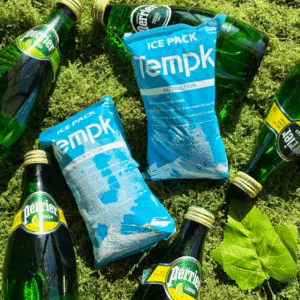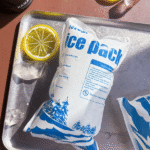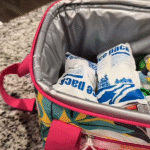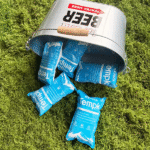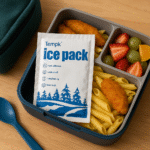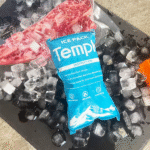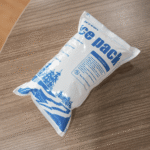Sí, ¿el hielo seco reventará una bolsa sellada? si el gas no puede escapar. El hielo seco se convierte directamente en gas CO₂; acerca de 1 lb produce aproximadamente 250 litros. Si atrapas ese gas en una película sellada, la presión aumenta hasta que la bolsa se hincha o falla. en el próximo 7 minutos, aprenderás a desahogarte, tamaño, y etiquete el embalaje para que usted esté seguro, obediente, y frio.
-
La física detrás de la presión: por qué voluntad hielo seco reventó una bolsa sellada en carriles comunes
-
Ventilación que realmente funciona: simple, Formas validadas de detener ráfagas en tránsito.
-
Opciones de contenedores que importan: qué diseños de cajas aumentan o reducen el riesgo de CO₂
-
Hielo seco del tamaño adecuado: reglas prácticas para no sobrecargar a su transportista
-
2025 actualizaciones: Tendencias y actualizaciones de SOP que mejoran la seguridad y el cumplimiento.
¿Por qué el hielo seco revienta una bolsa sellada durante el envío??
Porque la sublimación crea mucho más gas del que puede contener una película sellada, ¿El hielo seco reventará una bolsa sellada? sin camino de ventilación. El hielo seco se mantiene a -78,5 °C y salta la fase líquida., entonces el volumen de gas se dispara. Los segmentos más cálidos aceleran esto. Una cremallera sellada, sellado térmico, o bolsa metalizada atrapa CO₂ y convierte su bolsa en un recipiente presurizado.
Desde tu perspectiva: No necesitas ecuaciones para ver el riesgo.. Imagínate dos bañeras de gas de tan solo 1kg. Coloque eso detrás de un sello perfecto dentro de una hielera hermética y el punto débil, generalmente la costura, cederá.. La solución es humilde: no lo selles; guiar el gas hacia afuera. Utilice microventiladores, una boca plegable y plegada, o una hendidura diseñada. Agregue una ruta de ventilación en el cargador exterior, también.
¿Cuánto CO₂ es suficiente para hacer fallar una bolsa sellada??
Regla general: 1 libra ≈ 250 L de CO₂ en condiciones ambientales. La superficie importa; Los pellets se subliman más rápido que los bloques., entonces la presión aumenta antes. para mantener el control, diseñar un respiradero predecible para que el “modo de falla” sea ventilación intencional, no es un reventón de costura aleatorio.
| Que tamaño | Figura típica | Por que importa | Lo que significa para ti |
|---|---|---|---|
| Gas per 1 lb | ~250 litros de CO₂ | Supera con creces el volumen de la bolsa | Ventile la envoltura interior; siempre |
| Pellets vs.. bloquear | Los pellets gasean más rápido | Más superficie | Prefiere película ventilada para pellets |
| segmento cálido | >20 °C para 6+ h | Acelera la sublimación | Agregue respiraderos y divida la masa |
| Cargador VIP | Ganancia de calor muy baja | El gas todavía se acumula | Ventilación interior + exterior por diseño |
Consejos prácticos que frenan las roturas
-
Paquetes pequeños (≤5 lb): Doblar y plegar con un espacio de 3 a 4 mm o 1 a 2 microventilaciones cerca de la parte superior..
-
Paquetes medianos (5–15 lb): dos micro-respiraderos en lados opuestos, o una tira estrecha sin sellar.
-
Paquetes grandes (>15 lb): dividido en dos bolsas ventiladas más pequeñas; agregar un respiradero de alivio exterior.
-
Películas de barrera (p.ej., Mylar): Úselo solo con ventilaciones diseñadas; nunca sellar completamente.
-
Validación: prueba en un ambiente cálido durante toda la duración del carril +20% buffer; registrar temperatura y CO₂.
Instantánea del mundo real: Una línea farmacéutica redujo las explosiones de bolsas a más de la mitad después de cambiar de una bolsa de barrera sellada a dos más pequeñas., bolsas ventiladas dentro de un contenedor de EPS con muescas en la tapa. El rendimiento de la temperatura se mantuvo dentro de la banda durante seis meses de pruebas.
¿Cómo se debe empaquetar para que el hielo seco no reviente una bolsa sellada??
Comience simple: doblar, no sellar. Luego asegúrese de que el gas también pueda escapar del exterior expedidor.
Paso (listo para el operador):
-
Elige el interior: Kraft multicapa de boca abierta para bloques; film ventilado/microperforado para pellets.
-
cerrar la boca: doblar y plegar; si grabando, dejar una vía de escape despejada en el pliegue.
-
Ventilar el exterior: haga una muesca en la tapa de espuma, abrir un desagüe más fresco, o use un tapón de ventilación con filtro.
-
Hielo del tamaño adecuado: Evite el exceso de hielo habitual.; Divida la masa en bolsas para una liberación de CO₂ más suave..
-
Marcar el remitente: “Hielo seco – UN1845” y peso neto del hielo seco (kilos). Capacitar a los equipos sobre apertura segura.
¿Qué materiales reducen la posibilidad de que el hielo seco reviente una bolsa sellada??
LDPE/HDPE ventilado Funciona cuando necesitas durabilidad y control de pellets.. kraft + PE ligero Es indulgente y respira naturalmente cuando está plegado.. PET metalizado (Mylar) ofrece una gran barrera pero debe incluir respiraderos.
| Material | Comportamiento del CO₂ | Cuando usar | Para ti |
|---|---|---|---|
| LDPE/HDPE ventilado | Liberación controlada | Bandear, carriles generales | Menos fallos en las costuras |
| kraft + revestimiento de polietileno | Pliegue transpirable | Bloques, traspasos minoristas | Simple, Apto para ESG |
| Mylar (metalizado) | Atrapa gas | Sólo con ventilaciones diseñadas | Barrera + seguridad, si está ventilado |
¿El hielo seco explotará una bolsa sellada dentro de contenedores comunes??
Puede, así que asume que sí.. Un mejor aislamiento ralentiza el calor pero no elimina el gas. Los VIP pueden aumentar Riesgo de sobrepresión si olvida las rejillas de ventilación porque el gas se acumula silenciosamente..
-
Espuma EPS: Haga una muesca en una esquina de la tapa para mantener un camino de escape limpio..
-
Puro / bolsas rígidas: use un tapón de ventilación o un espaciador de tapa.
-
cajas VIP: combine microventilaciones interiores con una ventilación filtrada exterior; añadir una etiqueta de advertencia de CO₂.
¿Cuánta ventilación es “suficiente” para que el hielo seco no reviente una bolsa sellada??
Diseño para el peor segmento.. mas masa, temperaturas más altas, cajas más apretadas, y las películas de alta barrera exigen más desfogue. Utilice esta autocomprobación rápida para decidir antes de empacar.
Autocomprobación del riesgo de explosión (1-minuto)
Respuesta Sí/No a cada uno: dos respuestas “Sí” significan agregar ventilación o dividir la masa.
-
¿Está la bolsa interior completamente sellada sin vía de escape??
-
¿Es la película una barrera alta? (p.ej., mascota metalizada)?
-
¿La carga es ≥5 lb? (2.3 kg) por bolsa?
-
¿El embalaje exterior es hermético o tiene juntas??
-
¿Cruzará segmentos cálidos? (>20 ° C) para 6+ horas?
¿Qué documentación previene incidentes de tipo “el hielo seco revienta una bolsa sellada”??
El cumplimiento es sencillo si se estandariza.
-
Etiqueta: “Hielo seco – UN1845”, peso neto (kilos), Clase 9 marca para el aire.
-
Sops: detallar los métodos de ventilación por nivel de peso; incluir fotografías de pliegues/respiraderos aceptables.
-
Registro: trazas del registrador de datos para temperatura; observe cualquier deformación de la caja; registrar los pesos de los paquetes en cada pedido.
-
Capacitación: guantes y protección para los ojos; carteles que digan “ventilar antes de abrir” en bolsas y refrigeradores.
2025 Novedades y tendencias en el envasado de hielo seco.
¿Qué hay de nuevo en 2025? Tres frentes: películas más inteligentes, cajas más inteligentes, y una planificación más inteligente. ¿El hielo seco reventará una bolsa sellada? con menos frecuencia cuando usas Microventilaciones sensibles a la presión que se abren a baja PSI y se vuelven a cerrar en reposo. Los transportistas externos ahora envían con tapones de ventilación integrados y canales de difusión de gases. Los equipos están adoptando modelado de carriles digitales para igualar la masa de hielo y ventilar a la hora, Fallos de corte y desperdicio de material..
Lo último de un vistazo
-
Ventilaciones inteligentes: Películas que se abren bajo baja presión para evitar que se rompan las costuras..
-
Tapas ventiladas: Los canales moldeados y los tapones filtrados mantienen el aislamiento pero dejan salir el CO₂..
-
Modelado de carriles: herramientas rápidas que ajustan el tamaño correcto de hielo y ventilación según el tiempo de ruta y el mapa ambiental.
Insight del mercado: Crecimiento en productos biológicos, kits de comida, y los alimentos congelados transfronterizos favorecen diseños que equilibren el rendimiento y la seguridad. Los SOP con reconocimiento de ventilación reducen los rechazos, mejorar las puntuaciones de auditoría, y créditos por daños más bajos.
Preguntas frecuentes
Q1: ¿El hielo seco reventará una bolsa sellada??
Sí. La expansión del gas en una película hermética aumenta la presión hasta que la bolsa se hincha o falla. Utilice un cierre plegable o microventilaciones diseñadas.
Q2: ¿Los refrigeradores previenen fallas??
No. Una bolsa interior sellada aún puede explotar dentro de una hielera. Ventile tanto la envoltura interior como el cargador exterior..
Q3: ¿Puedo hacer un solo agujero??
A menudo por ≤5 libras, un orificio de 2 a 3 mm cerca del pliegue funciona, pero valide en un ambiente cálido. Las cargas más grandes necesitan ventilación distribuida o una tira no sellada..
Q4: ¿Son seguras las bolsas de Mylar??
Sólo si está ventilado. Las películas metalizadas son excelentes barreras y no debe estar completamente sellado alrededor del hielo seco.
Q5: ¿Cuánto hielo seco por 24 horas?
Depende del transportista y la ruta.. Muchos carriles pesan entre 5 y 10 libras cada 24 horas: modele su carril y evite el exceso de hielo habitual.
Resumen & recomendaciones
Puntos clave: ¿El hielo seco reventará una bolsa sellada? si atrapas CO₂. Evite eso con una envoltura interior ventilada, un camino de alivio en el cargador exterior, y hielo del tamaño adecuado. Divida masas grandes en bolsas ventiladas más pequeñas. Valide en un ambiente cálido con poco tiempo y documente sus SOP.
¿Qué hacer a continuación?: Estandarice dos patrones de ventilación por nivel de peso; agregue una muesca en la tapa o un tapón de ventilación a su cargador; y agregue un simple "paquete ventilado?” verifique el control de calidad de su línea de paquetes. CTA: Necesita un POE específico para el carril con fotografías y texto de aceptación? Hable con nuestros ingenieros de embalaje.
Acerca de Tempk
Diseñamos envases de cadena de frío que equilibran la seguridad, actuación, y sostenibilidad. Nuestro portafolio incluye bolsas de hielo seco ventiladas, Soluciones híbridas Mylar‑Kraft, y transportistas de alivio de CO₂ validados para productos farmacéuticos, biotecnología, y logística de alimentos congelados. Con modelado de carriles y guías de control de calidad, te ayudamos a enviar más frío, más seguro, y más inteligente.
Siguiente paso: Solicite una plantilla gratuita de “empaque ventilado” adaptada al tamaño de su transportista, tiempo de ruta, y formato hielo seco.






